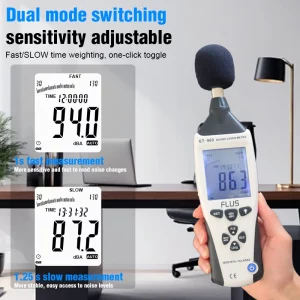RECENT POSTS
Share:
- July 20, 2024
Table of Contents
Sound level meters, also known as sound measuring equipment, play a crucial role in ensuring safe and healthy working environments, particularly in settings where noise levels can reach harmful levels. In many cases, measuring sound levels is a priority, as monitoring sound levels is important for worker or visitor safety to avoid harmful sound levels.
In this article, we will explore 10 tips for successful sound measurements, focusing on the proper use of sound level meters and sound measuring equipment.

1. Choose The Right Sound Level Meter And Measuring Equipment
The first step in successful sound measurements is selecting the appropriate sound level meter and measuring equipment for user-specific needs. Consider factors such as the frequency range, accuracy, and measurement capabilities of the equipment. Ensure that the sound level meter and measuring equipment are suitable for the environment and the type of sound the user intends to measure.
2. Understand The Basics Of Sound Level Meters
Before using a sound level meter, it is essential to have a good understanding of its basic functions and features. Familiarize yourself with the different settings, such as a-weighting and c-weighting, and learn how to calibrate the device properly. Knowing the ins and outs of
a user’s sound level meter will help the user obtain accurate measurements.
3. Calibrate Your Equipment Regularly
Calibration is key to ensuring the accuracy of sound level meters and measuring equipment. Regularly calibrating your devices according to the manufacturer’s guidelines will help maintain their precision and reliability. Additionally, calibrate the equipment before each measurement session to account for any environmental factors that may affect the readings.
4. Position The sound Level Meter Correctly
The placement of the sound level meter is crucial for obtaining accurate measurements. Ensure that the microphone is positioned at the correct height and distance from the sound source, and avoid obstructions that could interfere with the readings. Additionally, consider the impact of wind and other environmental factors on the placement of the equipment.
5. Take Multiple Measurements
To account for variations in sound levels over time, it is advisable to take multiple measurements at different locations within the area of interest. This approach will provide a more comprehensive understanding of the sound environment and help identify any potential sources of excessive noise.
6. Consider The Time Of Day
The time of day can significantly impact sound levels, especially in urban environments. Factors such as traffic, industrial activities, and human activities can vary throughout the day, leading to fluctuations in sound levels. When conducting sound measurements, consider the time of day and its potential influence on the readings.
7. Use Sound Measuring Equipment For Environmental Monitoring
In addition to measuring sound levels in specific locations, sound-measuring equipment can also be used for environmental monitoring. By continuously monitoring sound levels over time, users can identify patterns, trends, and potential sources of noise pollution, allowing for informed decision-making and mitigation strategies.
8. Protect User Equipment From Environmental Factors
Sound level meters and measuring equipment are sensitive instruments that can be affected by environmental factors such as moisture, dust, and extreme temperatures. Take precautions to protect user equipment from these elements, and store it in a safe and controlled environment when not in use.
9. Analyze And Interpret The Data
Once you have collected sound measurements, it is essential to analyze and interpret the data effectively. Look for patterns, outliers, and trends in the readings, and consider the context in which the measurements were taken. This analysis will provide valuable insights into the sound environment and potential areas for improvement.
10. Stay Informed About Regulations And Standards
Finally, staying informed about regulations and standards related to sound levels is crucial for ensuring compliance and promoting a healthy acoustic environment. Familiarize yourself with local, national, and international guidelines for acceptable sound levels in different settings, and use this knowledge to guide user measurement practices.
In conclusion, successful sound measurements require the right equipment, proper techniques, and a thorough understanding of the sound environment. By following these 10 tips and utilizing sound level meters and sound measuring equipment effectively, users can obtain accurate and reliable sound measurements for various applications. Whether it’s for occupational safety, environmental monitoring, or sound engineering, mastering the art of sound measurements is essential for promoting a quieter and more harmonious world.
0


